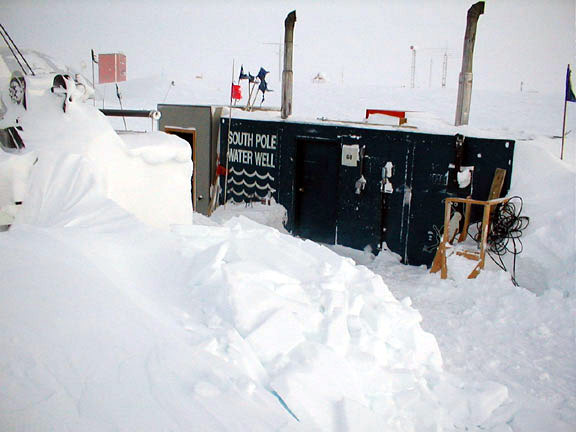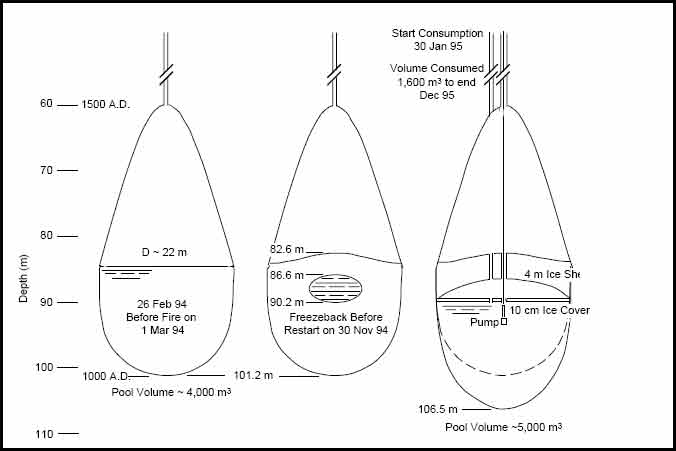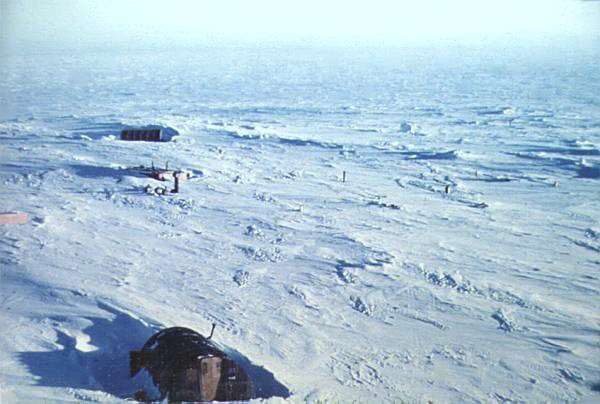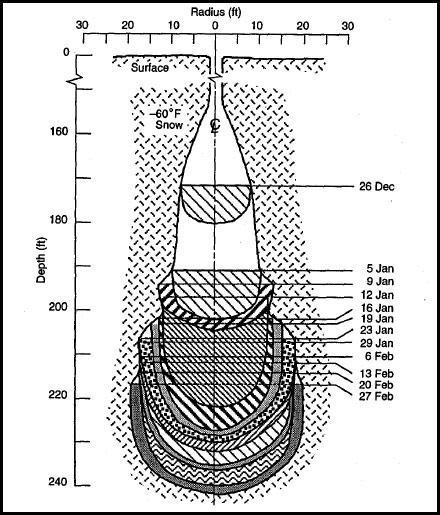Down the Hole--Rodwell Adventure Videos(or, more than you probably ever wanted to know about the rodwell)
Well, okay, so most of this is like watching paint dry...but anyway, once upon a time in 2002-03 Ken Keenan and the UTs sent a Hi-8 video camera down the old rodwell in preparation for its conversion into the sewer bulb. There were multiple trips up and down--some down the actual well hole, and some down the side hole that was involved with the meteor recovery project. More spectacular are the videos of explosives being lowered, followed by their detonation in an attempt to break up the ice lens at the top of the well (this ice lens did not go away...during the 2005 winter (then as the sewer bulb) it froze over and had to be melted through (with less violent means). Above is a January 2001 photo of the structure which housed this old rodwell; the structure was removed to the berms in 2004-05. This was actually the second rodwell at Pole, the first was installed in 1972-73--read on. The well idea was originally developed by Army engineer Raul Rodriguez, for Camp Century, Greenland in 1960-61--hence the name Rodriguez Well. Below, another view of the surface installation after the 2001 winter. So...what is a Rodriguez well? To start one...a hole is created through the firn into the solid icecap, several hundred feet below the surface, using a sort of drill and/or by dumping lots of hot water into an initially created hole. At some point a "bulb" of melted ice is created, partially filled with water. At this point, a submersible pump is installed, water from the bulb is pumped to the surface, heated up, and then reintroduced into the bulb. As this process continues, the bulb slowly expands into a significant reservoir of water, and eventually there is enough water so that some of it can be withdrawn and used by the station. 
The equipment in the above photos was originally installed in 1991-92, housed in two stacked milvans which were placed in a pit (what you see here is the upper milvan, which was originally on the surface). The supporting piping systems in the power plant included the waste heat recovery silencers and associated heat exchangers, pumps, etc., were installed the following summer in 1992-93. Then the story is that CRREL wanted it to be circulated for a year before it was put into service (or, the story is that the water treatment stuff didn't make it to Pole in time)...anyway the well wasn't certified for use until near the end of the 1993-94 summer. Before use really started in March 1994 winter there was a serious power outage (which required use of the emergency generators--full power wasn't restored for 3 hours). The next day the heat trace caught fire, possibly as an aftermath of the power outage and the system froze up. So the snow melter was used for 1 more winter, and CRREL came back the following summer to see what had happened. Some of the water in the well was still liquid, but a thick ice lens had frozen over the top of the water surface--this ice lens still bothers our sewage today.  Profiles of well in 1995 Part of this exercise was to study the conditions of the hole in preparation for blowing up the ice lens...after all that was done we see the explosives going down the hole, followed by the ultimate cloud of dust. The videos were on 3 tapes, for this web site I've picked and clipped a few of the shorter and more interesting items. If you really like watching paint dry I can share the larger files, including some unrelated stuff like the CNN reporter who tried unsuccessfully to get C to take off his sunglasses. I've edited out the long periods of total inactivity. In a couple of cases a radio was lowered along with the camera so that audio (and depth measurements) could be heard, in other cases the only sound is the scraping of the camera along the side of the hole. Of course there is sometimes some interesting commentary from the participants before and/or after each time the camera is lowered. These are .mpg files which should play on any computer after downloading. What is here:
TIME SIZE MB
downhole 5:16 75
camera going down 6:06 83
lowering TNT 2:57 26
starring Dave, Rob, Marty
explosion 0:42 7
The explosion date 11/28/02 per the writing on the original tape cassette.
For those of you with a technical interest, I've thrown in two CRREL papers--one from March 1995 entitled Thermal Design of an Antarctic Water Well (Virgil Lunardini and John Rand) which describes the design of the well seen in these videos based on the performance of the first (1972-73) experimental Pole rodwell, and Collecting Micrometeorites from the South Pole Water Well (Susan Taylor and others) which covers the 1995-96 meteor collection project but also describes the construction and performance of the well.
A few comparative numbers: Water consumption of the first well averaged 550 gallons per day for the last 3 weeks of operation (there were 22 w/o's on station; I've been told that the well was the only station water source in use). Temperature of the water coming from the well was 34°F, water returned to the well was 70°F. Well final diameter was 39'; depth to the water surface was 217' and water depth was 24'. By comparison, the domed station rodwell was (as of 12/95) producing an average of 1450 gallons per day, well diameter was about 80', depth to the water surface was 295', and depth of water was 52'. The current well was producing about 2450 gallons per day in 2005, depth to the water surface was 390', and water depth was 72'. The efficiency of the first two wells was in the same order of magnitude as the present one (30 gallons of water produced per gallon of fuel). The earlier wells at Camp Century, Greenland, used steam injection rather than recirculated water; reported efficiency was significantly greater (55 gallons of water per gallon of fuel; of course the ice temperature was probably warmer than that at Pole). Below, a 1977 aerial view (from one of the antennas) of the "NCEL Jamesway" which housed the equipment for the first rodwell. Behind this structure is a buried portion of Old Pole; power plant stacks and a temporary garage Jamesway are visible.  [top photo by Gerald Przbylski (Lawrence Berkeley National Laboratory), second photo by 2001 winterover Dana Hrubes; bottom photo from the 1977 Pole Soul photo archives. The above graphics and some of the historical data have been taken from the above referenced CRREL reports. And special thanks to Ken Keenan for the video!] Okay...here is an update...photos of the third rodwell building (officially named Rodwell 1 (RW1) based on the elevated station timeline), completed in 2001-02. The fourth rodwell building (RW2) was completed in 2006-07 as was the startup drilling, but it was not put in service until New Years weekend 2012-13. It had been circulating water during the 2012 winter. But moving the sewer bulb would not happen until 2013-14. A related part of the rodwell development would turn out to be...the ice tunnels that connected the business ends of the water and sewer connections, in the utilidor and elsewhere. Plans for these originated in the early 1990's with the idea that there should be a sub-snow utility and pedestrian tunnel from the proposed elevated station to the dark sector. That story, and what really happened, are documented on these next two pages. |
 At left is a diagram of the first rodwell. It was never intended for cold weather operation (it was housed in a Jamesway, see photo below), but it was used for several months until the fuel line to the boiler froze up (the DFA fuel in use in the 1970's/80s gelled at -70°F temperatures). Why wasn't a rodwell incorporated into the new (domed) station? I don't know--perhaps because the fancy conveyor snow melter system had already been procured as part of the Emerson power plant building, or perhaps because the failure of the experimental well made people question the concept. Too bad, since the touted snow conveyor system never worked, and the 1975 winter crew had to weld up a new snow melter before they could be assured of a water supply.
At left is a diagram of the first rodwell. It was never intended for cold weather operation (it was housed in a Jamesway, see photo below), but it was used for several months until the fuel line to the boiler froze up (the DFA fuel in use in the 1970's/80s gelled at -70°F temperatures). Why wasn't a rodwell incorporated into the new (domed) station? I don't know--perhaps because the fancy conveyor snow melter system had already been procured as part of the Emerson power plant building, or perhaps because the failure of the experimental well made people question the concept. Too bad, since the touted snow conveyor system never worked, and the 1975 winter crew had to weld up a new snow melter before they could be assured of a water supply.